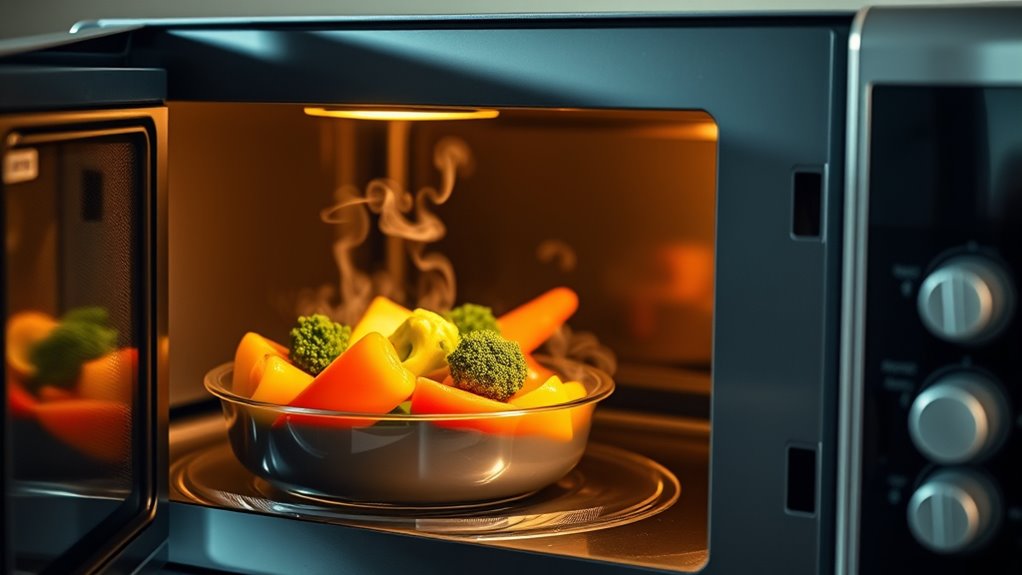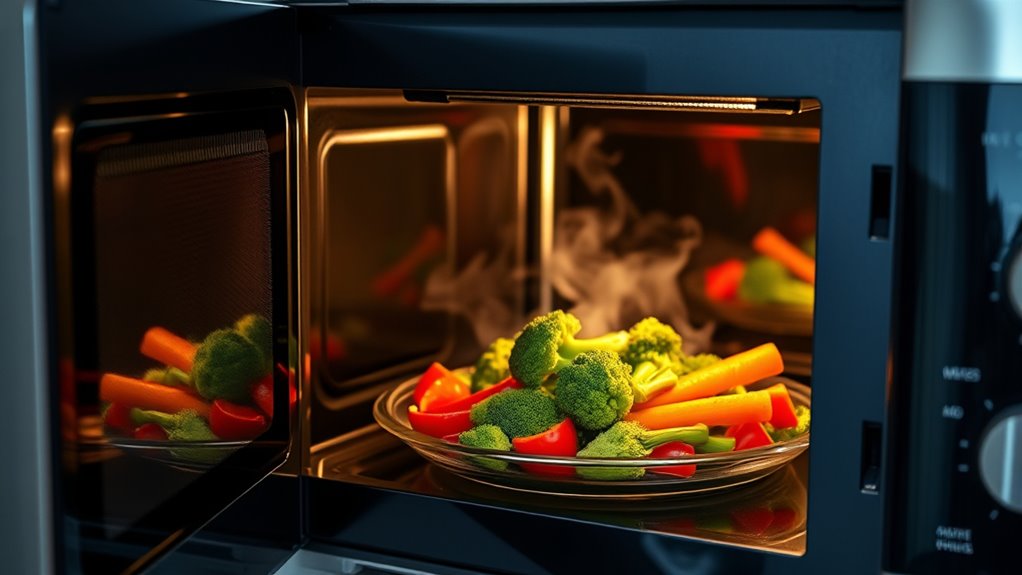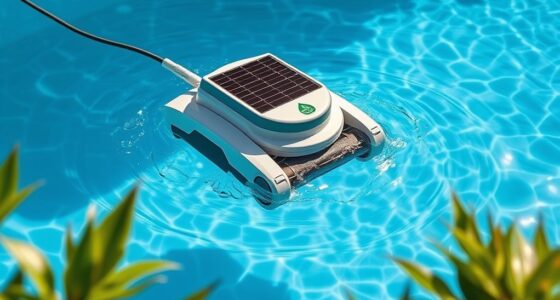Microwave ovens don’t zap nutrients or cause harmful radiation when used correctly. They work by vibrating water molecules to generate heat, which doesn’t damage the food’s health benefits. Proper use and maintenance guarantee safety, and cooking quickly with less water helps retain vitamins like C. Myth-busting shows microwaves are just as safe and nutritious as other methods—so, if you want to learn more about how they really work, keep exploring the facts.
Key Takeaways
- Microwave cooking preserves nutrients as effectively as boiling or baking when used properly.
- Shorter cooking times and less water help retain water-soluble vitamins like vitamin C.
- Microwave radiation is non-ionizing and cannot cause molecular changes or mutations in food.
- Proper maintenance and safe operation prevent radiation leaks, ensuring food safety.
- When used correctly, microwave cooking does not zap nutrients or harm food’s health benefits.

Microwaves are a common kitchen appliance, but many myths about their safety and functionality persist. One of the most common concerns people have involves whether microwaves destroy nutrients or alter the food’s health benefits. It’s understandable to worry about how cooking methods impact what you eat, especially when it comes to vitamins and minerals. But the truth is, microwave cooking is just as safe and nutritious as other methods like boiling or baking, provided you use the appliance correctly.
Microwave cooking preserves nutrients just as well as boiling or baking when used correctly.
A frequent misconception is that microwave radiation somehow makes food unsafe or unhealthy. The reality is, microwave ovens use non-ionizing radiation, which doesn’t have enough energy to change the molecular structure of your food or cause mutations. Instead, microwaves heat food by causing water molecules to vibrate, generating heat from within. This process is fast and efficient, preserving more nutrients than some traditional cooking methods that expose food to heat for longer periods. For example, boiling vegetables can cause water-soluble vitamins like vitamin C to leach out, but microwaving tends to retain more of these nutrients because of shorter cooking times and less water use.
Some folks worry about recycling concerns, especially as they relate to disposing of or upgrading their appliances. If you’re concerned about environmental impact, it’s good to know that microwave ovens are generally recyclable. Many communities have programs to properly dispose of or recycle old appliances, which helps prevent electronic waste from ending up in landfills. Proper recycling ensures that hazardous components, such as certain plastics and electronic parts, are handled safely, reducing environmental harm. When replacing a microwave, look for local recycling options rather than tossing it in the trash, which can be harmful to the environment. This way, you’re not only maintaining appliance safety in your own home but also contributing to safer recycling practices that protect the planet.
Regarding appliance safety, microwaves are built with multiple safeguards. Modern models have door interlocks and shielding to prevent microwave radiation from escaping during operation. As long as your microwave is in good condition and used according to the manufacturer’s instructions, it’s safe to operate. Keep the door seals clean and intact, and avoid attempting to repair or modify the appliance yourself. If you notice sparks, strange smells, or the microwave isn’t heating properly, it’s best to have a professional check it out. Proper maintenance and use ensure your microwave remains a safe and reliable appliance.
Frequently Asked Questions
Can Microwave Cooking Cause Radiation Exposure?
You might wonder if microwave cooking causes radiation exposure. Rest assured, microwave safety is well-regulated, and modern microwaves emit non-ionizing radiation that doesn’t harm you. They use microwave radiation to heat food, but it’s contained within the oven, preventing exposure. As long as your microwave is functioning properly and there’s no damage to the door seals, you won’t face radiation risks. So, microwave cooking is safe when used correctly.
Are Microwave Ovens Safe for Pregnant Women?
While no method is entirely without risk, microwave ovens are generally safe for pregnancy safety when used properly. You should avoid overheating food or using damaged appliances, as these can introduce microwave risks. For expecting moms, it’s wise to follow safety guidelines, like using microwave-safe containers and ensuring proper food heating. Ultimately, sticking to recommended practices helps minimize concerns and keeps you and your baby protected.
Do Plastic Containers Release Toxins When Microwaved?
When you microwave food in plastic containers, plastic leaching can occur, especially if the containers aren’t labeled microwave-safe. This means harmful toxins might transfer into your food, risking your health. To guarantee container safety, always use microwave-safe plastics and avoid heating food in containers not meant for microwave use. This simple step reduces the risk of toxin exposure and keeps your meals safe and healthy.
How Do Microwaves Compare to Other Cooking Methods Nutritionally?
When comparing microwaves to other cooking methods, you’ll find that microwaves maintain nutrients better because they use less water and cook faster, reducing nutrient loss. Their cooking efficiency means you preserve more vitamins and minerals than boiling or frying. So, if you want to maximize nutrient retention and save time, microwaving is a smart choice. It’s a convenient, healthy way to prepare your meals without sacrificing nutritional value.
Is There a Difference Between Microwave and Conventional Oven Nutrient Retention?
You’ll find that microwave and conventional ovens differ in nutrient loss and cooking efficiency. Microwaves cook food faster, often preserving more nutrients because they use less heat exposure. Conventional ovens take longer, which can lead to increased nutrient loss due to extended heat. So, if you want to maximize nutrient retention, microwaving is generally more efficient. However, both methods can be healthy if you avoid overcooking your food.
Conclusion
So, next time you reach for your microwave, don’t let myths cloud your mind. It’s not a villain stealing nutrients but a trusty tool that preserves freshness and speeds up your day. Think of it as a gentle wizard, quietly working its magic without draining your food’s energy. Embrace the truth, and let your microwave be a friend, not a foe—turning your kitchen into a haven of convenience and health, one zap at a time.









